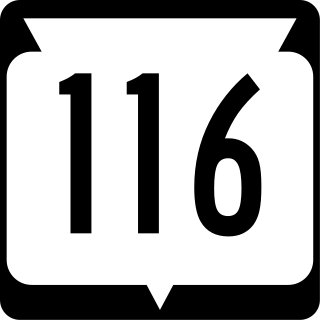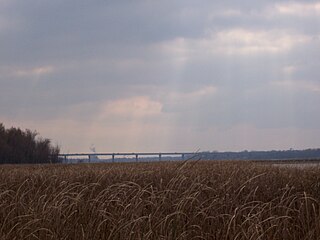
Winnebago County is a county in the U.S. state of Wisconsin. As of the 2020 census, the population was 171,730. Its county seat is Oshkosh. It was named for the historic Winnebago people, a federally recognized Native American tribe now known as the Ho-Chunk Nation. Chief Oshkosh was a Menominee leader in the area. Winnebago County comprises the Oshkosh-Neenah, WI Metropolitan Statistical Area, which is included in the Appleton-Oshkosh-Neenah, WI Combined Statistical Area.

Menasha was a town in Winnebago County, Wisconsin, United States. The population was 18,498 at the 2010 census, making it the second most populous town in the state of Wisconsin at the time of its dissolution. The unincorporated community of Waverly Beach was located partially in the town. In an April 2016 referendum, the portion of the town west of Little Lake Butte des Morts voted to become the village of Fox Crossing. The remaining portions of the town were annexed to Fox Crossing on September 22, 2016, effectively ending the existence of the town.
Winneconne is a town in Winnebago County, Wisconsin, United States. The population was 2,350 at the 2010 census. The Village of Winneconne is located within the town, on both sides of the Wolf River. The unincorporated community of Butte des Morts, named for a French and Native American trading war, is also located in the town. The town's water resources of rivers and lakes makes it a center of hunting and fishing, including winter ice fishing.

The Fox River is a river in eastern Wisconsin in the Great Lakes region of the United States. It is the principal tributary of the Bay of Green Bay, and via the Bay, the largest tributary of Lake Michigan. The well-known city of Green Bay, one of the first European settlements in North America, is on the river at its mouth on lower Green Bay.

Lake Winnebago is a shallow freshwater lake in the north central United States, located in east central Wisconsin. At 137,700 acres it is the largest lake entirely within the state, covering an area of about 30 miles by 10 miles, with 88 miles of shoreline, an average depth of 15.5 feet, and a maximum depth of 21 feet. It has many shallow reefs along the west shore, and a drop-off type shoreline on the east. There are several islands along the west shore.

The Fox–Wisconsin Waterway is a waterway formed by the Fox and Wisconsin Rivers. First used by European settlers in 1673 during the expedition of Marquette & Joliet, it was one of the principal routes used by travelers between the Great Lakes and the Mississippi River until the completion of the Illinois and Michigan Canal in 1848 and the arrival of railroads. The western terminus of the Fox–Wisconsin Waterway was at the Mississippi at Prairie du Chien, Wisconsin. It continued up the Wisconsin River about 116 miles (187 km) until reaching Portage, Wisconsin. There travelers would portage to the Upper Fox River, or eventually, use the Portage Canal. It continued about 160 miles (260 km) down the Fox River, following it through Lake Winnebago and continuing on the Lower Fox over 170 feet of falls to the eastern terminus of Green Bay.

The Wolf River is a 225 mi (362 km) long tributary of the Fox River in northeastern Wisconsin in the Great Lakes region of the United States. The river is one of the two National Scenic Rivers in Wisconsin, along with the St. Croix River. The scenic portion is 24 miles (39 km) long. The river and its parent the Fox River and associated lakes are known for their sturgeon which spawn every spring upstream on the lower river until blocked by the Shawano Dam. The river flows through mostly undeveloped forestland southerly from central Forest County in the north to Lake Poygan in the south. The lake is part of the Winnebago Pool of lakes fed by both the Fox and Wolf Rivers. The Fox-Wolf basin is usually considered to be a single unified basin and the rivers themselves may be referred to as the Fox-Wolf River system.

Area code 920 is a telephone area code in the North American Numbering Plan (NANP) for a large area of eastern Wisconsin. It was created on July 26, 1997, in a split from area code 414, which formerly served the entire eastern third of the state. 920 is scheduled to be overlaid with area code 274 on May 5, 2023.

Porte des Morts, also known as Porte des Mortes, the Door of Death, and Death's Door is a strait linking Lake Michigan and Green Bay between the northern tip of the Door Peninsula and the southernmost of the Potawatomi Islands. At its narrowest reach between Plum Island and the peninsula, the Porte des Morts Passage is about one and one third miles across. The name is French and means, literally, "the door of the dead".

Big Lake Butte des Morts is a shallow freshwater lake located in the U.S. state of Wisconsin, in Winnebago County. It is part of the Winnebago Pool of lakes in east central Wisconsin, along with Lake Winnebago, Lake Poygan, and Lake Winneconne. The lake is fed by the Fox River in the southwest and the Wolf River draining from Lake Winneconne in the northwest, and drains via the Fox River southeast into Lake Winnebago. The lake is part of the Butte des Morts region in Winnebago County, Wisconsin. This lake is not connected to Little Lake Butte des Morts, which is located to the north, downstream of Lake Winnebago, fed by the lower Fox River.

Lake Poygan, located in the U.S. state of Wisconsin near the village of Winneconne, is an expansive widening of the Wolf River totaling over 14,000 acres (57 km²). Lake Poygan is part of the Winnebago Pool or Wolf Chain, a series of interconnected lakes fed by both the Fox and Wolf rivers. The eastern third of the lake is often referred to as Lake Winneconne. In the Menominee language it is called Pawāhekaneh, "Wild Rice Threshing Lake", referring to the traditional importance of wild rice cultivation to the local economy.

State Trunk Highway 116 is a state highway in the US state of Wisconsin. It runs in north–south in east central Wisconsin from the unincorporated community of Waukau to Butte des Morts.

Little Lake Butte des Morts is a lake in the US state of Wisconsin, eight miles north of Lake Butte des Morts. It is part of the Fox–Wisconsin Waterway and receives its inflow from a short segment of the Fox River which drains from the north end of Lake Winnebago around Doty Island. The north end of Little Lake Butte des Morts becomes the section of the Fox River running to Green Bay. The lake is part of the Butte des Morts region in Winnebago County, Wisconsin. The southern half of the lake is located within the cities of Menasha and Neenah.
The siege of Little Butte des Morts was a battle fought during the Fox Wars, in Wisconsin, and Michigan. The battle was fought at Little Lake Butte des Morts, in what is now Winnebago County, Wisconsin, in 1716. At the time, the Fox had a massive stronghold at Butte Des Mortes, with possibly thousands of inhabitants. New France, knowing that Butte Des Morts was an important stronghold during the Fox Wars, laid siege to the fort. The French brought two pieces of cannon and a grenade mortar. The siege lasted three days, much longer than the French had anticipated. Butte des Morts was attacked by New France again in 1730, led by Paul Marin de la Malgue.
Butte Des Morts is a region of northeastern Wisconsin, in Winnebago County, containing two known lakes: Little Lake Butte des Morts, and Lake Butte des Morts. Little Lake Butte des Morts lies between the Menasha region from the town of Menasha, while Big Lake Butte des Morts lies in the northwest side of the city of Oshkosh, Wisconsin.

Butte des Morts is an unincorporated census-designated place in the town of Winneconne, in Winnebago County, Wisconsin, United States.

The Wiouwash State Trail is a rail trail in northeastern Wisconsin. Its name is derived from the first two letters of the four counties it traverses: Winnebago, Outagamie, Waupaca, and Shawano. The trail's Tribal Heritage Crossing of Lake Butte des Morts is a nationally designated recreation trail. The trail is used by walkers, hikers, bikers, horseback riders, and snowmobilers during the winter months. Two sections of the trail are complete: 24 miles from Aniwa south to Split Rock and 21 miles from Hortonville south to Oshkosh.
Fox Crossing is a village in Winnebago County, Wisconsin, United States. It was incorporated from the former Town of Menasha in 2016. The population as of the 2020 census was 18,974.

The Friendship Trail is a recreation trail in northeastern Wisconsin. The trail is used by walkers, hikers, bikers, horseback riders, and snowmobilers during the winter months. Two sections of the trail are complete: ~14 miles from Winchester east to Fox Crossing and ~4.4 miles from Forest Junction southeast to Brillion. The route consists of asphalt, crushed stone, and wood surfaces. The entire route is located in Winnebago County and Calumet County.















